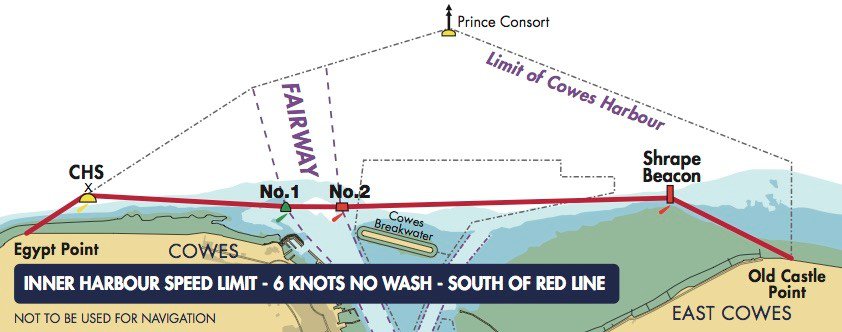Essential Safety Information
04 January 2022
(This notice replaces Local Notice to Mariners 24 of 2020, which is hereby cancelled)
The following safety advice is brought to the attention of all harbour users.
1. Inner Harbour speed limit 6 knots – no wash
All craft shall comply with the regulations on speed and wash in Cowes Harbour. The red line on Figure 1 below indicates the northern boundary of the Inner Harbour and the speed limit of 6 knots with no wash.

Figure 1: Red line indicates northern boundary of the Inner Harbour and speed limit of 6 knots – no wash
Cowes Inner Harbour rules on speed and wash – key points:
• The speed limit in the Inner Harbour is 6 knots through the water.
• The 6 knot speed limit applies in the Inner Harbour at Cowes and within 100 metres of the Mean High Water Mark west and east of the harbour entrance as far as Egypt Point and Old Castle Point.
• Navigate with care and caution and keep a good lookout all around for other vessels and for swimmers in the water off the beach at Prince’s Green in Cowes.
• Do not create wash in any part of the Inner Harbour and within 100 metres of the shore from Egypt Point to Old Castle Point.
• Cowes Harbour Commission’s emphasis is on education in the first instance, but CHC will, if required, take enforcement action.
Note that the CHS special mark buoy has now been repositioned to provide a visual indication to harbour users of the north-western limit of the Inner Harbour “6 knots speed limit and no wash” area.
See Local Notice to Mariners No. 05 of 2022 – Speed Limit and Wash in Cowes for full information.
2. Wear a Lifejacket
Lifejackets are one of the most necessary pieces of equipment to have when enjoying boating or watersports. The Royal National Lifeboat Institute are an excellent source of information on this subject and give the following key advice:
• You must have enough lifejackets on board. This means having lifejackets to suit all shapes and sizes including children and pets.
• It is the skipper’s responsibility to show the crew where lifejackets are stored, how to wear and secure them and when and how to operate them.
• The RNLI recommends that when you use your tender and your boat everyone wears a buoyancy aid or a lifejacket.
More information can be found at: rnli.org/safety/lifejackets
3. Wear a kill cord on-board powered craft
The kill cord serves one purpose, to stop the engine when the driver moves away from the controls. It is essential that all owners and operators of vessels fitted with kill cords:
• Test kill cords regularly to ensure that the engine stops when the kill cord mechanism is operated.
• Make sure that the cord is in good condition.
• Always attach the cord securely to the driver, ideally before the engine is started, but certainly before the boat is put in gear.
• Stop the engine before transferring the kill cord to another driver.
See Local Notice to Mariners No. 12 of 2016 – Use of Kill Cords On-Board Powered Craft for full information.
4. Don’t drink and go boating
The Royal Yachting Association (RYA) and the British Ports Association (BPA) fully support the Government in raising alcohol awareness and highlighting the dangers of drinking and boating. Although many recreational users enjoy boating responsibly, unfortunately, the issue of drinking in the marine environment has contributed to incidents around the UK coast, including at Cowes. The message is clear – don’t mix alcohol and boating.
The RYA encourages all boaters to behave responsibly and to understand how alcohol can affect their safety and the safety of others. Put simply, alcohol distorts your perception of risk and your own abilities; it affects your balance, impairs your judgement, and slows your reactions.
Cowes Harbour General Direction 3.6. Navigating whilst under influence of Drink or Drugs contains the local rule on alcohol and boating, which is:
• No person shall navigate or attempt to navigate a vessel when unfit by reason of drink or drugs.
5. CCTV coverage in Cowes Harbour
CHC uses harbour-wide CCTV to improve the safety management and security of our harbour to provide:
• Enhanced safety and security for harbour users
• 24/7 CCTV coverage to supplement CHC’s Harbour Patrol Capability
• Evidence to enforce and/or prosecute under the Cowes Harbour General Directions.
See also Local Notice to Mariners No. 07 of 2022 – Use of CCTV and Video Images for Safety and Security.
This Local Notice to Mariners shall remain in force until further notice.

